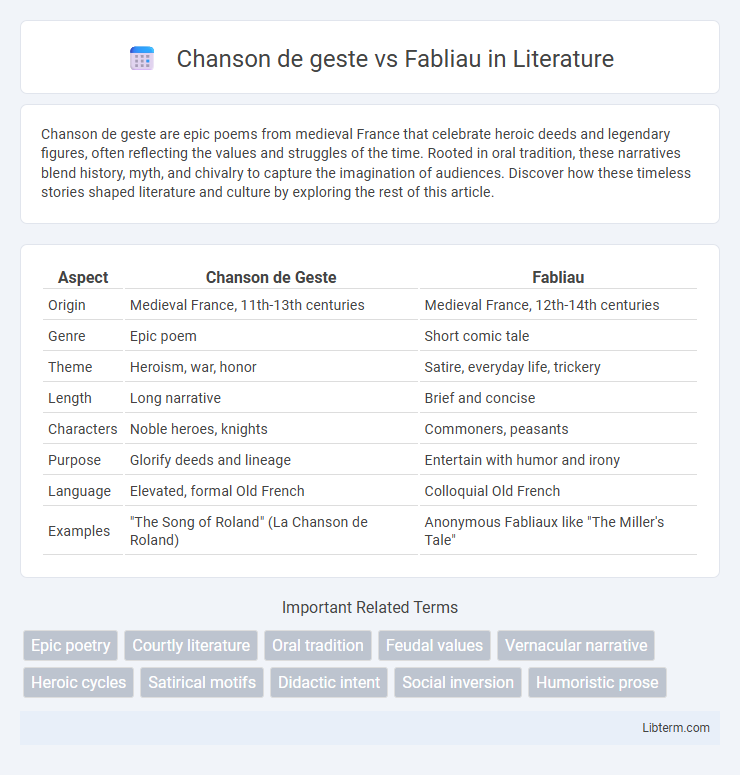Chanson de geste are epic poems from medieval France that celebrate heroic deeds and legendary figures, often reflecting the values and struggles of the time. Rooted in oral tradition, these narratives blend history, myth, and chivalry to capture the imagination of audiences. Discover how these timeless stories shaped literature and culture by exploring the rest of this article.
Table of Comparison
| Aspect | Chanson de Geste | Fabliau |
|---|---|---|
| Origin | Medieval France, 11th-13th centuries | Medieval France, 12th-14th centuries |
| Genre | Epic poem | Short comic tale |
| Theme | Heroism, war, honor | Satire, everyday life, trickery |
| Length | Long narrative | Brief and concise |
| Characters | Noble heroes, knights | Commoners, peasants |
| Purpose | Glorify deeds and lineage | Entertain with humor and irony |
| Language | Elevated, formal Old French | Colloquial Old French |
| Examples | "The Song of Roland" (La Chanson de Roland) | Anonymous Fabliaux like "The Miller's Tale" |
Introduction to Chanson de Geste and Fabliau
Chanson de geste are epic poems from medieval France, celebrating heroic deeds and historical battles through elaborate storytelling and formal verse, often centered on legendary figures like Charlemagne. Fabliaux are short, humorous tales written in verse, highlighting everyday life with satire and bawdy humor, reflecting the concerns of common people during the same period. Both genres illustrate distinct facets of medieval French literature, with Chanson de geste emphasizing nobility and valor, while Fabliaux focus on social critique and comedy.
Origins and Historical Context
Chanson de geste originated in medieval France during the 11th and 12th centuries, embodying epic poetry that celebrated heroic deeds of knights and noble figures within the context of feudal society and the Crusades. Fabliaux emerged slightly later, around the 12th and 13th centuries, as short, comic, and often bawdy tales circulating among the urban and clerical classes, reflecting a more secular and satirical perspective on everyday life. These contrasting origins highlight the chanson de geste's role in reinforcing aristocratic values, while the fabliau reveals popular culture's shift towards humor and subversion during the High Middle Ages.
Defining Characteristics of Chanson de Geste
Chanson de geste are epic poems originating in medieval France, characterized by their heroic themes, focus on legendary knights, and often patriotic or religious motifs illustrating the values of feudal society. These narratives emphasize chivalric ideals, honor, and large-scale battles, conveyed through elevated, formulaic language and repetitive structures to aid oral transmission. Unlike fabliaux, which are short, comedic, and often satirical tales about everyday life, chansons de geste serve as grand historical epics celebrating noble deeds and heroic lineage.
Key Features of Fabliau
Fabliaux are short, comedic, and often bawdy tales written in verse during the medieval period, characterized by their satirical take on everyday life and lower-class characters. Their key features include fast-paced plots, straightforward language, and a focus on tricks, deception, and bodily humor, serving as a contrast to the heroic and noble themes in Chansons de geste. Fabliaux frequently expose human folly and social hypocrisy through farcical scenarios and sharp wit.
Themes and Motifs: Heroism vs Humor
Chanson de geste centers on themes of heroism, valor, and loyalty, often depicting legendary knights and epic battles to celebrate noble ideals and medieval chivalry. Fabliaux emphasize humor, satire, and everyday life, using witty, bawdy tales to mock social norms and human follies. The heroic motifs in chansons de geste contrast sharply with the fabliaux's focus on comic situations and clever tricks.
Social and Cultural Functions
Chanson de geste served as epic poems that reinforced feudal values and heroic ideals, often performed to promote loyalty and valor among medieval nobility. Fabliaux, by contrast, functioned as short, humorous tales that mocked social norms and clerical corruption, resonating with the emerging bourgeoisie and lower classes. Both genres played distinct roles in shaping medieval society by reflecting and challenging contemporary social structures through oral and written traditions.
Literary Structure and Style
Chanson de geste features epic poetry characterized by lengthy, formulaic verses and elevated diction emphasizing heroic deeds and nationalist themes, typically composed in laisses with assonance or rhyme. Fabliau employs short, rhymed, octosyllabic couplets with a concise, straightforward narrative style focusing on humor, satire, and everyday life, often subverting social norms. The structural contrast highlights chanson de geste's solemn, repetitive grandeur versus fabliau's brisk, witty, and colloquial approach.
Audience and Reception
Chansons de geste, epic narrative poems popular in medieval France, were primarily performed for noble audiences, emphasizing heroic deeds and genealogical pride that reinforced feudal values. Fabliaux, in contrast, catered to a broader, often urban and bourgeois audience, using humor, satire, and bawdy themes to entertain and critique social norms. The reception of chansons de geste involved collective participation in courtly settings, whereas fabliaux found popularity in more informal, public spaces, reflecting differing social functions and audience engagement.
Notable Examples and Analysis
The Chanson de geste, exemplified by "The Song of Roland," features epic tales of heroic deeds and medieval warfare, highlighting themes of feudal loyalty and Christian valor. Fabliaux, such as "The Miller's Tale" found in Chaucer's *Canterbury Tales*, provide short, humorous, and often ribald stories focused on everyday life and social satire. Analyzing these genres reveals the contrasting narrative purposes: the Chanson de geste reinforces societal ideals through grand, historical storytelling, while Fabliau critiques social norms with wit and irony.
Lasting Influence on Medieval Literature
The Chanson de geste, exemplified by "The Song of Roland," left a profound impact on medieval literature through its epic portrayal of heroic deeds and chivalric values, shaping the narrative framework of later romance and chanson traditions. Fabliaux, known for their satirical and humorous depiction of everyday life, influenced medieval literature by introducing relatable, often subversive themes that challenged social norms and provided a counterpoint to the lofty ideals of epic poetry. Both genres contributed enduring narrative techniques and thematic diversity, enriching medieval literary culture and informing the evolution of European storytelling traditions.
Chanson de geste Infographic

 libterm.com
libterm.com